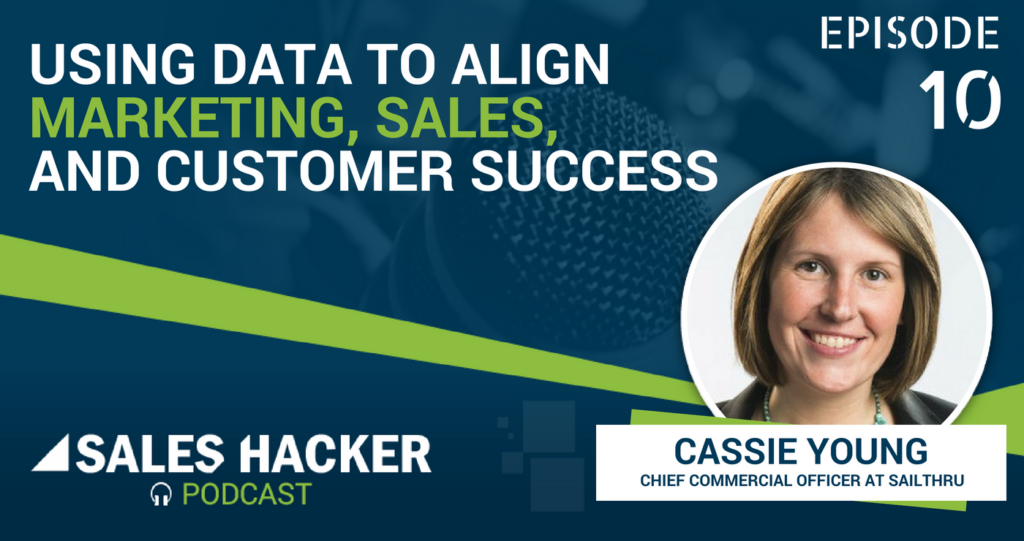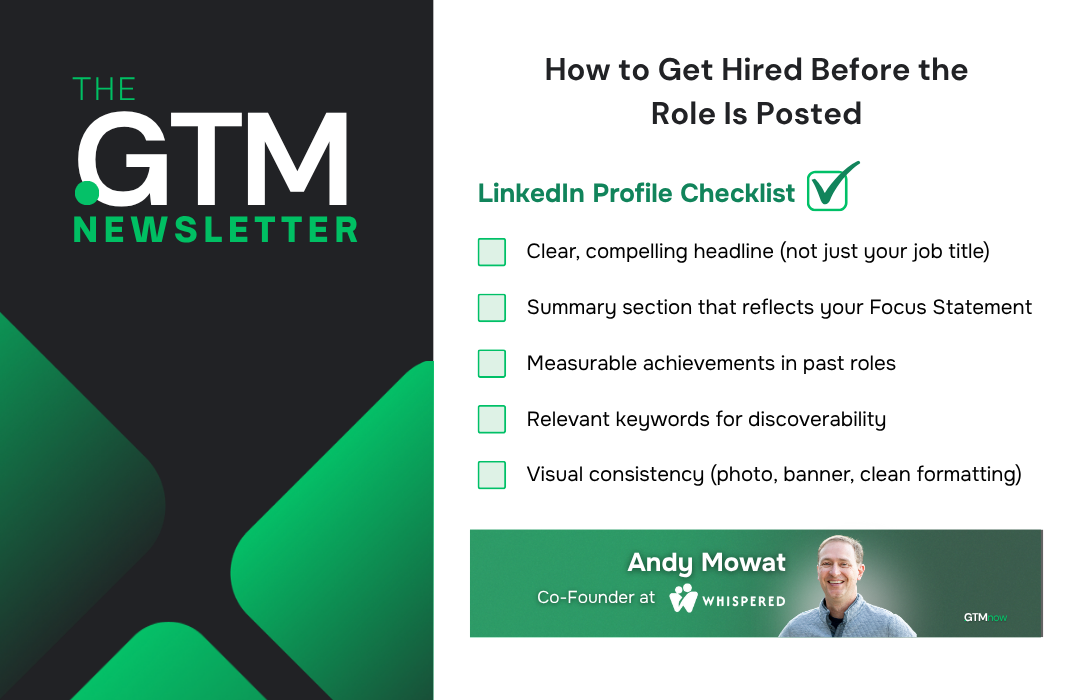On this episode of the Sales Hacker podcast, we talk with Cassie Young, Chief Commercial Officer at Sailthru about how data driven decision making can bring sales, marketing, and customer success all on the same page.
What You’ll Learn
- Building a cash-flow positive organization
- Messaging and managing through challenges
- The Rule of 40 – Using data to measure your business
- Aligning the Finance org and the Commercial org to align the executive team
- The transition from investment banking to startup executive
- Using data to tell effective stories about your business
- The growth of the NYC tech scene
Subscribe to the Sales Hacker Podcast
Show Agenda and Timestamps
2) About Cassie Young and Sailthru [0:41]
3) Cash flow positivity and the Rule of 40 [3:57]
4) Cassie and her startup journey [6:50]
5) The startups ecosystem in New York [23:48]
6) Data driven decision making and the customer journey [27:42]
7) Quick-fire Questions [36:20]
Sales Hacker Podcast—Sponsored by Gong.io
Sam Jacobs: Before we start, a quick thank you to this month’s Sales Hacker podcast sponsor Gong — the #1 conversation intelligence platform for sales. Gong helps you generate more revenue by having better sales conversations. It automatically captures and analyzes your team’s conversations so you can transform your team into quota-shattering super-sellers.
And now on with the show.
About Cassie Young and Sailthru: Baseball Card Stats
Hey everybody, welcome to the Sales Hacker podcast.
I’m your host Sam Jacobs. We’ve got a great show today. I’m going to be interviewing Cassie Young, who is the Chief Commercial Officer at Sailthru. She’s one of the top marketing and sales leaders in New York City.
Highly regarded across the startup ecosystem. She’s been at Sailthru for five years. Prior to joining Sailthru, Cassie was a long-time direct marketer who built a strong personal brand around data-driven marketing. Welcome, Cassie!
Cassie Young: Thanks, Sam, for having me. I’m excited to be here!
Sam Jacobs: First things first, we want to get your, as we call it, your baseball card stats out of the way. Just to frame your experience and perspective for everybody that’s listening.
CCO—I don’t hear that title a lot. What does it stand for?
Cassie Young: It’s “Chief Commercial Officer”. We went in the direction of “Chief Commercial Officer” because we thought “CRO” had a bit more of a sales tone. This could be daunting on the client services side of things, which is how we netted out where we did.
Sam Jacobs: Tell us about Sailthru.
Cassie Young: Absolutely! Sailthru is a marketing software company that is focused on two verticals. We work with media and publishers as well as retail, e-commerce businesses to help them personalize their experiences for their customers.
Effectively, what we do is we take a brand like Business Insider. We then track what their readers are doing across various channels and make it easy for Business Insider to recommended content via email, their website, and mobile app. Mostly through push notifications.
Cash Flow Positivity and the Rule of 40
Sam Jacobs: Let’s just jump into it. Sailthru hasn’t raised money in four and a half years. That’s awesome and rare. What’s the operational perspective on the business that’s driving that decision or non-decision?
Cassie Young: We talk about our company goals in three broad buckets. We keep these consistent year over year even though the numbers change. I’ll explain how this ties into the raise in a minute.
These are:
- Grow our business.
- Be a trusted partner to our clients.
- Operate predictably and responsibly.
I think we are in good shape where we will be cash flow positive for the entirety of 2018. This is a decision we set at the executive level that we are bringing down into the trenches
Here at Sailthru, we tend to think a lot about the Rule of 40. What is your growth rate—top line plus your EBITDA.
This is why companies that are growing at 80% year over year could be losing at a 40% margin and still be good because they hit that Rule of 40.
Cassie and Her Startup Journey
From Savored, to GLG and then Sailthru
Sam Jacobs: Tell us how you got into startups and what your journey was.
Cassie Young: I’ve been in the startup land in New York for 12 years. It’s been pretty fascinating to see the changes here over that time. I started my career in investment banking, covering media and tech companies.
theladders.com was my first foray into tech—I absolutely loved it. All the different nuances of businesses and how they worked. I stayed there through the credit crisis and recession in ‘08 and then bleeding into ‘09. In 2009, I headed out to do my MBA. After which, I worked with Savored, GLG, and now Sailthru.
Making a break for marketing
Sam Jacobs: How did you figure out where to go when you were leaving the banking world?
Cassie Young: The number one thing for me was finding a role that was quantitatively charged, but not finance.
It’s not until I started poking around and speaking to people that I realized that when direct response marketing was done well, it was no different than really managing long-term financial analysis.
Ladders gave me a chance to really become a subject matter expert on subscription marketing, consumer marketing, and data-driven marketing. When I was working for the President of the Consumer Division at AOL, I spent a lot more time on the macro business. I started inward with marketing and then took roles from that part forward that had adjacencies in other parts of the business.
The Startups Ecosystem in New York
Sam Jacobs: Give us your take on the market, the startup ecosystem. You are a thought leader in this space.
Cassie Young: I’m super excited to see the state of where New York City is at right now! Going from a small handful of venture-backed companies to—you’re tripping over them in the street these days. There’s a lot of first time founders who underestimate just how hard it is to build a company.
I do worry that we see this trend of people who want to be a founder or CEO and just force-fit a business idea to be a founder. I guess in summary—I love seeing all the momentum.
Data Driven Decision Making and the Customer Journey
Sam Jacobs: Tell us about the transition to running the sales team and what you think are the benefits and disadvantages?
Cassie Young: What’s been really interesting is learning what your best customer looks like. That can be in terms of the industries that they are in. What I mean by that is we’ve learned a lot from customers who work with third party development teams. They tend to not really do well with Sailthru. We need to better account for that in the sales process.
Balancing the pipeline and post-sale process
Our minimum deal size right now on paper is $75,000 a year. Inevitably what happens is people are working smaller deals. It’s the end of the quarter—boom!—and somehow an exception is made.
I know that the customers that are smaller than that consume an insane amount of time from our Customer Success Managers (CSMs). So, we actually have our CSMs time-track. The band of clients that’s under $100k ACV take more than 30% of our CSM’s time! The imbalance is insane!
Those customers tend to have higher churn rates. I want to sell to them when they get a little bit bigger, but now is not the right time. Much to the chagrin of the sales team, I now have an alert coming from Salesforce if anyone tries to move a deal into pipe that’s below this size.
The one nice thing for me in running both sales and customer success is that I talk about our company framework of goals before. My number for growing our business is an exit ARR number no matter how we get there.
Short-term versus long-term wins
Now, we of course have to bring ample new logos in. More than growing logos, how do we mitigate churn and ensure a strong growth from the install base. When it’s end of quarter and you need the $50k to meet quota, you can’t just close based on that logic. Because when it doesn’t play out, it’s $50k you have to win back.
We had this challenge where sales would have a plan. If we missed the plan we had to go back and reforecast before every board meeting. There was just one missing step between sales and finance. Whereas now, that’s a joint effort of figuring out exactly what the plan needs to look like. How do we derive the compensation plans? It’s just very thoughtful.
Quick-Fire Questions
Who should SDRs report to?
Cassie Young: I think they should report to sales. The biggest lesson I’ve learnt at Sailthru is that one pipeline number (owned by the Commercial team) works best. Marketing should have a lens into this, sure.
Sales and marketing stack
Cassie Young: Salesforce, Marketo, SalesLoft, LeanData, FunnelWise, eDataSource.
Composition of field sales versus inside sales
Cassie Young: The composition of the team right now is one SDR to two SDs. The SDR team is about seven. 14 are out in the field. It’s a ballpark because in some places we will double up when we are trying to get off the ground.
Cassie’s role models
Cassie Young: Mike DeLuca—EVP Advertising Sales at Hearst, Marc Cenedella—Founder and CEO at Ladders Inc., and Brad Svrluga and Benjamin Sun from Primary Venture Partners.
Favorite read
Cassie Young: The Other Side of Innovation
How to get in touch with Cassie
Cassie Young: cyoung@sailthru.com
Sam Jacobs: Awesome! Well, Cassie thank you so much.
Cassie Young: Yeah, thanks again for having me, Sam.
Sam’s Corner
Hi, everybody this is Sam’s Corner. Another amazing interview. They are all amazing, aren’t they? I think Cassie Young really was incredibly insightful, incisive, and her experience in the startup ecosystem here in New York is second to none.
One of the things that Cassie was talking about was her emphasis on transparency. She walked through a cadence. A series of communication platforms that she uses to enforce transparency. One of those things is a weekly email that she sends out on Monday nights.
Don’t Miss Episode 11
To check out the show notes, see upcoming guests, and play more episodes from our incredible lineup of sales leaders, visit gtmnow.com/podcast-subscribe
You can also find the Sales Hacking podcast on iTunes or Stitcher. If you enjoyed this episode please give us a share on LinkedIn or Twitter.
Finally, a special thanks again to this month’s sponsor, Gong. If you want to get in touch with me, find my social handles in my bio below.
I’ll see you next time!







